On this page you'll find information on how to identify a badger, how to distinguish a badger from other animals that are often mistaken for them, and how to identify tracks.
For information on how to identify badger burrows visit this page.
What does a badger look like?

Generally the coat is a grizzled grey, and the face with distinctive black and white markings
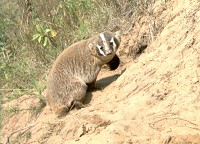
The coat colour often includes tinges of red and brown (especially when the badger is covered in soil).

A badger's chest and neck are white, though this isn't always obvious

The low stature and often shaggy skirt of fur often obscure a badger's black legs
Badgers are short and stocky animals, with a wide and "flattened" appearance. They are about 60 to 72cm (23 to 30 inches) long from nose to rump, with males being larger than females. On average, a female badger weighs 7kg (15.5 pounds), whereas a large male can weigh up to 11kg (25 pounds). In general they are about the size of a large raccoon, though they often look larger (especially from a distance) due to their heavyset build.
The overall coat colour of a badger is a grizzled grey, which may be mixed with brown, red, black, and even yellow. The chest and neck are white. The badger's face is certainly the most distinctive feature with black and white cheek patches and a white stripe that runs from nose to neck. From the front, it appears that the badger has alternating black and white stripes running from the front. Its relatively large ears are on the sides of its head. Its legs are black, though due to the badger's short stature and often shaggy "skirt" of fur, they aren't always clearly visible.
A badger's adaptations for digging give it a unique and somewhat awkward movement above ground. They are not particularly quick on their feet and tend to "waddle" when running. Their fur can sometimes obscure their feet and give them the impression of "flowing" across the ground. A badger's short tail is not usually noticed, being the same colour as rest of the body and generally held low.
More information on some of the specific features that can be used to identify badgers is found below.
A Badger's unique features
Although badgers have a characteristic appearance, there are many times when identification is not simple. This can be a particular challenge when we are trying to identify animals that have been killed on the road (and scavenged or decomposed) or when trying to identify animals in photographs.In general there are three features you should pay attention to when trying to determine whether you are indeed looking at a badger: Claws, Head, and Tail.
Claws: There isn't an animal in Ontario that comes close to having such proportionally long front claws as a badger – up top 1.5 inches (3.8 cm) long. When these are seen they are unmistakable. Claws might not be seen on a live badger, but on a road-kill they will remain as long as the rest of the skeleton, and are often the best means of identification. Keep in mind, that only the front claws are this long; the hind claws are similar in size to other similar sized mammals.
Head: The black and white markings on a badger's head are very distinctive. Most unique is the white stripe running lengthwise from the nose to the back of the neck. There are also conspicuous black and white patches on each cheek (they appear as stripes when looking at the badger directly from the front). A badger also has large ears for its size, and they are positioned on the side of the head, rather than the top of the head like most other Ontario mammals.
Tail: A badger actually has a fairly long tail. But because it is the same colour as the rest of the body, and often held closely to the body, it isn't always very conspicuous. However, the presence of a furry tail that is the same colour as the rest of the body can still help to eliminate other options, such as raccoons or opossums.

The badger's front claws are about 1.5 inches long. No other Ontario mammal has such proportionally long claws

The most distinctive feature of the facial markings is the white stripe that goes from the nose to the back of the neck. Also notice that a badger's rounded ears are on the side – and not the top – of its head

A badger's tail is the same colour as its body, has no patterns, and is furry (but not overly bushy). On a live badger, it often goes unnoticed.
Commonly mistaken animals
The mammals most often confused with badgers are raccoons, groundhogs, opossums, and even skunks. The differences may seem obvious at first glance, but there can be many similarities between these that can make identification surprisingly confusing at times. All of these other animals are far more likely to be seen and far more likely to be living in towns and cities.
Groundhog (Woodchuck)
 Groundhogs actually have a very similar body shape to a badger (wide and stout, with short legs). They
also share a relatively short and furry (not naked) tail that is the same colour as the body. However, groundhogs
are generally a solid brown (not grizzled like the badger), and have no distinct markings on their face. They are
also about half the size. Groundhogs live in burrows that can resemble those of badgers (badgers actually eat
groundhogs, and will often dig them out of their burrows). Groundhogs are herbivores, so if you saw the animal
eating flowers or plants, it was probably not a badger.
Groundhogs actually have a very similar body shape to a badger (wide and stout, with short legs). They
also share a relatively short and furry (not naked) tail that is the same colour as the body. However, groundhogs
are generally a solid brown (not grizzled like the badger), and have no distinct markings on their face. They are
also about half the size. Groundhogs live in burrows that can resemble those of badgers (badgers actually eat
groundhogs, and will often dig them out of their burrows). Groundhogs are herbivores, so if you saw the animal
eating flowers or plants, it was probably not a badger.
Opossum
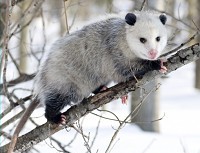 The opossum
is a relative newcomer to Ontario, having migrated north from the US over the last several decades. Its most
distinctive feature is its naked, rat-like tail. The opossum's body is generally a light grey overall. It has a
white face with dark ears and eyes. Like a badger, it has dark legs, but its feet are small and very hand-like.
Generally speaking they are much smaller than badgers.
The opossum
is a relative newcomer to Ontario, having migrated north from the US over the last several decades. Its most
distinctive feature is its naked, rat-like tail. The opossum's body is generally a light grey overall. It has a
white face with dark ears and eyes. Like a badger, it has dark legs, but its feet are small and very hand-like.
Generally speaking they are much smaller than badgers.
Raccoon
 The raccoon
is the only Ontario mammal with a striped tail, and this usually remains visible even on road-killed raccoons for
weeks. The mask-like markings on a raccoon's face run horizontally across the face, rather than
lengthwise from the nose to the neck as on the badger. There is little mistaking this on a live animal but a
road-killed raccoon laying on its side may appear to have markings running the opposite direction. Raccoons are
roughly the same colour and size as a badger, but have longer legs and a humped back. A raccoon's front feet
look more like small "hands" with long digits (the actual claws are relatively short, compared to the
badger's), while a badger's looks more like a dog's paw, albeit with extremely long claws.
The raccoon
is the only Ontario mammal with a striped tail, and this usually remains visible even on road-killed raccoons for
weeks. The mask-like markings on a raccoon's face run horizontally across the face, rather than
lengthwise from the nose to the neck as on the badger. There is little mistaking this on a live animal but a
road-killed raccoon laying on its side may appear to have markings running the opposite direction. Raccoons are
roughly the same colour and size as a badger, but have longer legs and a humped back. A raccoon's front feet
look more like small "hands" with long digits (the actual claws are relatively short, compared to the
badger's), while a badger's looks more like a dog's paw, albeit with extremely long claws.
Skunk
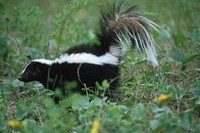 The skunk
is familiar to most people, and is a common night-time visitor. The colour is predominantly black. There is a small
vertical white stripe on the face, then a large patch on the top of the head, which diverges into two stripes down
either side of the back, though these aren't always as conspicuous as you'd think. The tail is bushy, mixed
with both white and black fur, and generally held high above the body.
The skunk
is familiar to most people, and is a common night-time visitor. The colour is predominantly black. There is a small
vertical white stripe on the face, then a large patch on the top of the head, which diverges into two stripes down
either side of the back, though these aren't always as conspicuous as you'd think. The tail is bushy, mixed
with both white and black fur, and generally held high above the body.
Badger tracks
Based on our experience, clear badger tracks are not commonly seen – even right in front of occupied burrows. But when conditions are ideal, they are very distinctive. The most distinctive feature of a badger's tracks are the long front claws. However, these claws, and the fact that they have 5 toes (like skunks and raccoons) rather than 4 toes (like dogs and cats), do not always show up in a print. When the claws are not visible, a badger track looks a bit like a cross between a large cat's track and a small dog's (a bit like a fox, in fact). Another helpful characteristic is that a badger is "pigeon-toed", which can be obvious if there enough tracks visible. The hind and front prints often overlap (double register), giving the impression of a much larger print, especially in soft sand when the distinction between the two tracks isn't obvious. Here are some links to great online resources for badger tracks, and tracking in general. There are several images included below. Please refer to the Links & Resources page for more resources on badger tracks.

Front print of a badger, showing the imprint of the front claws beyond the pad

Front print on the right, and on the lower left, a hind print. The hind foot lacks the very long claws of the front
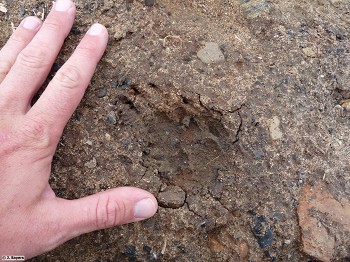
A front print in soft mud, causing more of the claws to imprint into the mud (rather than just the tips)
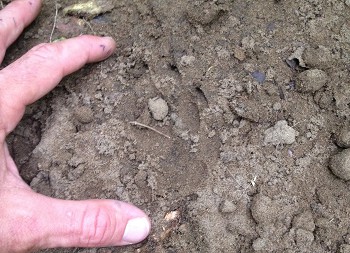
Another front print. The definition of the pad isn't great, but the front claw tips still clearly register in the soil

Front and hind prints often fall on the same location. Here both the front and hind paws have registered, but they overlap to some degree. Due to the substrate, the prints are poorly defined, but the claws on the front foot still register.

A very good imprint of the pad on the hind (left) and front (right) feet of a badger. The long claws of the front paw often only register as small holes in the soil

Front foot (with register of hind foot)

When a badger is walking, one front and one hind print partially overlap each other (called "indirect register"). In this case both prints are clearly visible. Badgers only have long claws on the front print, so it's only on one of each set of prints that the imprint of the long front claws are visible a few cm beyond the print of the pad.

In this case, only the imprint of the two or three most prominent claws on the front paws are visible. Each track once again is comprised of a front and hind print. The distance between each print is important for identification

A badger walking through dry sand. No details are visbible, either of the claws, number of toes, or shape of the pad. But the combination of the size of the print (one front and one hind tracks are combined in each print) as well as the space between each print can help to identify a badger.

Badger walking across a hard-packed, but recently rained-on surface. The pad prints are visible, but not conspicuous. But the imprint of two or three front claws is clearly visible. When conditions don't allow for full tracks, watch for the imprints of the claws at evenly spaced intervals

In soft soil the entire foot leaves a print. While discrimination between number of toes and claws is difficult, the pigeon-toed gait and distance between prints is very obvious. Note that each "print" includes both a front and hind foot print.

The gait of a badger compared to the gait of a tall adult male walking at a leisurely pace. The badger is walking toward the bottom of the photo.In this case, the imprint of the front claws is not visible, but the imprint of the pads (one front and one hind in each print) betrays the characteristic pigeon toed pattern.

A badger walking through snow. The snow is deep enough for the badger's low body to drag through. The prints are visible in the "trough" but due to the snow, are not overly distinctive on their own.
Identifying badger burrows
We have put together an entire page dedicated to identifying badger burrows
































